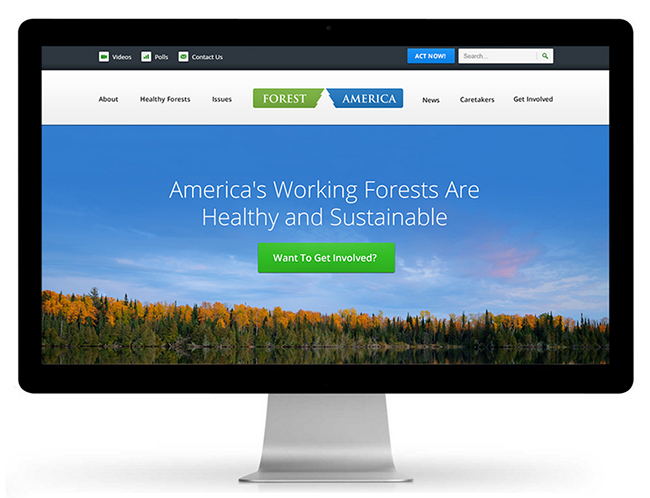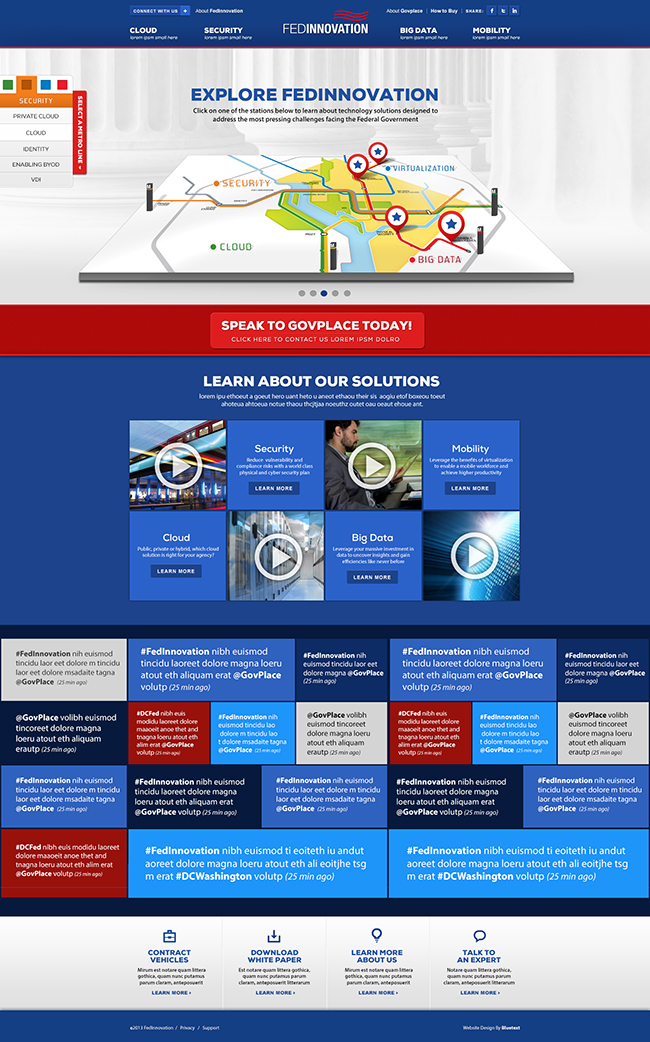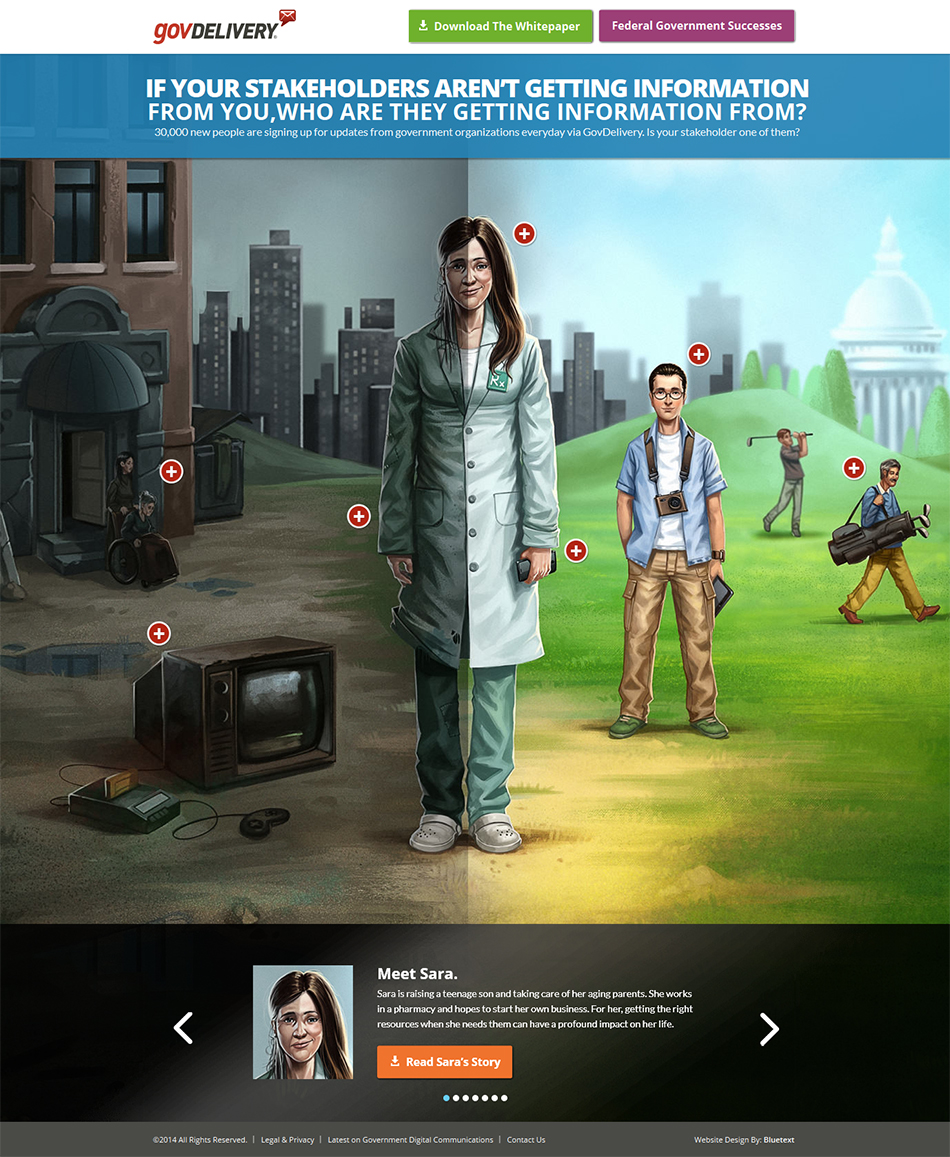The Mid Atlantic Marketing Summit is greater Washington’s largest annual symposium of thought leaders in marketing. The theme will focus on emerging technologies and trends in marketing communications. Topics will include: metrics, mobile, social media, multi-platform campaigns, online video campaigns, experiential advertising, B2B, business development, and much more. This summit will explore the disruptive technologies that are creating a major shift in how marketing and business development professionals reach their audiences and decision makers.
A presentation being given by:
Nick Panayi, Global Brand and Digital Marketing, CSC
Jason Siegel, Co-Founder & Chief Creative Officer, Bluetext
Location: Mid Atlantic Marketing Summit
Gannett Building
May 8th 3PM
Nick and I will be presenting on the customer journey and how digital marketing technologies are continuing to evolve, personalize and empower this very effective demand generation platform. We will drill deep into CSC’s massive digital infrastructure that supports many of their journeys, and most importantly the Bluetext produced CSC Digital Briefing Center.
Learn why CSC’s Digital Briefing Center was so strongly needed for their most critical journeys, the concepts considered, and how we got to this great performing end product.
Force3 marketing leaders Joel Moore and Tasha Klares talk about the Force3 rebranding efforts.
Force 3 is one of the fastest growing network security services and solutions company servicing the Federal Government with revenues of more than one billion dollars annually. When it’s brand, messaging and website needed an update it turned to Bluetext. We added a fresh set of colors and a new design with the sensation of motion to the logo, a theme that plays out across the website. We also created an animated introduction that uses the color palette to draw the visitor into the site.
The new website is infused with search engine optimization so that Force 3 comes up when customers are searching for network security solutions. One of the company’s key differentiators is the expertise and passion of its team of experts. That message is persistent across the site.
The imagery is clean and modern on each page.The new brand design plays out not only on the website, but in collateral, iconography, and a new trade show booth. It delivers a brand that is in tune with today’s government customer and differentiates their offering and value from competitors.
When it comes to marketing and communications, government contractors and public sector IT providers face a set of unique challenges. For one, the customer base of Federal, state and local decision makers responsible for purchasing technology products and services – ranging from CIOs and CTOs to program managers, IT managers and procurement officers –represents a finite group that can be difficult to reach.
Compounding this predicament is the fact that government contractors must not only market their brand, product and services to these decision makers, but also time these marketing efforts strategically. This means building awareness far enough in advance of a contract award, and then sustaining marketing and PR efforts throughout what can be a multi-year process from pre-RFP to the contract award – and even beyond due to potential contract protests, delays and budgetary obstacles.
Marketing to agency decision makers is just one piece of the puzzle. For small to mid-sized contractors, marketing and public relations efforts must often extend to larger prime contractors in order to ensure these lesser-known firms are on the radar when Primes are assembling teams to pursue contracts. Large contractors, for their part, must also market needs and capabilities to smaller partners that might hold an elusive product/service, market expertise, status or agency relationship.
We have assembled 6 ways that forward-thinking contractors and IT providers can grow their business and contract opportunities by looking beyond traditional marketing, advertising and public relations tactics.
Leverage responsive landing pages
esponsive design is a critical website approach for providing customers with a seamless experience across all device sizes. With a responsive website, government contractors and IT providers can be in front of buyers at every step of their online journey. A user viewing a website on the go via a mobile device can have the same powerful experience as when sitting in their office.
Responsive websites provide continuity between different viewing contexts, remaining completely agnostic to the type of device used and the size of the screen the user has. Responsive websites also rank higher in search engines’ rankings, as Google recommends responsive web design because having a single URL for desktop and mobile sites makes it easier for Google to discover content and for Google’s algorithms – which are constantly changing – to assign indexing properties to content.
It was the need for a responsive website that brought GovDelivery, which enables public sector organizations to connect with more people and to get those people to act, to Bluetext.
As the number one referrer of traffic to hundreds of government websites, including IRS.gov, SBA.gov, FEMA.gov, IN.gov, and BART.gov, the GovDelivery Communications Cloud is an enterprise-class, cloud-based platform that allows government organizations to create and send billions of messages to more than 60 million people around the world. Bluetext was hired by GovDelivery to help them reach public sector organizations that can benefit with tremendous cost savings while reaching more people, automating complex communications and driving mission value through deeper engagement with the public.
For this responsive design project, Bluetext conceived and designed a responsive landing page with an infographic demonstrating the benefits of using GovDelivery for government agencies as the centerpiece of the campaign. We also developed a responsive email template and infographic poster to be used across many marketing channels.
Extend reach and share budget with partner campaigns
While going it alone from a marketing and public relations perspective provides a company with more control over a campaign, it also can be costly and restrict the reach and impact that could otherwise be achieved by aligning in an innovative way with industry partners.
Bluetext has worked on numerous occasions with industry partners that align around a specific campaign targeting government decision makers. Govplace, a leading enterprise IT solutions provider exclusively to the public sector, turned to Bluetext to develop FedInnovation, a destination designed to help government agency executives get the latest information on current technology challenges and solutions for big data, cloud, security, mobility and storage. Developed in conjunction with leading technology providers including Dell, Intel Security and VMWare, it includes exclusive content, videos, blogs, and real-time social feeds.
FedInnovation combines relevant, fresh content, complementary offers, and financial resources to deliver an educational platform to drive awareness and leads for Govplace across its target market. The development of platforms is a continued focus for Bluetext as we look to conceptualize, design and develop creative solutions that deliver measurable business impact for our clients. It is increasingly clear that customers of our clients demand unique experiences with premium content delivered in an easy to consume manner.
Another partner campaign targeting U.S. public sector executed by Bluetext was FutureAgency.com, a digital content experience effort on behalf of McAfee and Intel that depicted virtually a “future government agency.” For this project, Bluetext created a virtual experience around client subject matter experts in an effort to present content for government decision makers in a more engaging fashion. Rather than static white papers and marketing slicks that often go unread or unfinished, Bluetext created an experience whereby avatars of actual company thought leaders were created, and they delivered presentations on topics in a virtual conference environment. The clients found length and quality of site visitor engagement superior to that of traditional white papers and similar content.
Create compelling digital experiences to reach decision makers
The web has become a go-to resource for decision makers to research products and services prior to purchase. Product sheets, white papers and other pieces of online collateral can be useful supporting resources for government decision makers, but will hardly help contractors stand out in a crowded marketplace.
Recognizing this, government contractors and IT providers are creating more dynamic, immersive digital experiences that can more effectively engage target constituencies and impact the decision making process. Additionally, these experiences are molded to be as valuable as any in-person interaction site visitors would have with products and services.
A recent Bluetext project showcases a forward-thinking technology provider, CSC, which was seeking to ensure prospective customers could have a similar experience as they would if they were physically at CSC’s corporate headquarters.
Bluetext designed and built CSC’s Digital Briefing Center, a virtual experience where clients and CSC’s entire ecosystem can come to learn about CSC’s key technology conversations across its target verticals.
Bluetext designed a virtual office building where each floor represents a specific vertical industry, and visitors can learn about CSC’s key solutions and experience across cloud computing, big data, applications, cyber security, and mobility. While not specific to the government market, it is indicative of how “stickier” digital experiences are reshaping how existing and prospective customers interact with content.
Highlight customer innovation
No matter how large or well-known a government contractor/Federal IT provider is, gaining approval from an agency to speak publicly about a technology project is often mission impossible. Agencies must be careful not to appear to endorse a specific vendor in public comments or a press release quote, and even when project leaders are amenable, the process often grinds to a halt with the more conservative public affairs officers.
As such, vendors often have their hands tied on how to showcase a successful project so that other agencies – or even other decision makers within the same agency – will take notice. An approach that can bear more fruit involves shining the spotlight on an agency leader or the agency itself through awards and speaking opportunities.
Multiple editorial publications and associations hold annual award programs that showcase outstanding IT projects and agency leaders at the federal, state and local government level. Agencies tend to be more open to sharing an IT story through an award because it demonstrates innovation and can assist with employee morale and retention.
Beyond award programs, there is also significant benefit in generating media coverage and awareness of state & local customer projects. These agency customers tend to be more amenable to participating in public relations campaigns, and the drawing attention to these projects can demonstrate capabilities to prospective Federal customers as well.
Develop targeted campaign to pursue a specific contract
As contractors and IT providers know all too well, winning an agency contract requires a very different sales cycle than a small business user signing up online for Dropbox or a similar “as-a-Service” software offering.
At some level, there will always be marketing activities designed to reach decision-makers across multiple civilian or military agencies – and in some cases both segments. These external efforts may involve communicating product capabilities, service chops, or the expertise of the contractor’s team. But in today’s hyper-competitive market for agency contracts, developing innovative, targeted campaigns in pursuit of a specific contract or that are designed to reach decision makers at a particular agency, can make the difference between a game-changing contract win and a devastating loss.
Bluetext is increasingly tasked to partner with contractors in developing innovative branding and outreach campaigns around a specific contract pursuit. In early 2014, L-3 Communications, in partnership with Harris Corporation, hired Bluetext to help them pursue the Air Force’s $1B Satellite Control Network (AFSCN) Modifications, Maintenance & Operations (CAMMO) Contract.
Bluetext worked with the L-3/Harris Capture teams to develop a campaign strategy that would position them as a Prime by highlighting the many advantages they bring to the table. The overarching campaign theme Bluetext developed is:
“The Power of Partnership, From Vision to Reality”
The creative strategy of this project began with the core concept of the ad, “from vision to reality.” The left side of the ad is a wireframe representing the vision with the right side representing its reality. After the wireframe of the satellite was created, it was overlaid on top of the red diagonal to create a striking visual element to draw attention to the campaign. The first series of ads were placed in high visibility areas inside of Colorado Springs Airport, a key travel hub for Air Force brass. The media plan for the campaign also includes online, print and OOH media placed strategically to maximize reach and frequency throughout the entire contract RFP and award lifecycle.
Focus on agency challenge, not yourself
Dramatic changes in staffing and mission of government IT media outlets means that the days of getting a product reviewed or corporate profile written are for the most part a thing of the past. As such, contracts and IT providers must get far more creative when it comes to communicating capabilities.
Government IT press don’t want to hear about products. They want to hear about trends and challenges sweeping through agencies, and how contractors and IT providers are developing solutions to solve those challenges.
This was the backdrop for a media strategy Bluetext architected for Adobe Government. Over the past few years, government-wide budget cuts have been swift and relatively unsparing in their impact on agency in-person conferences and training events. This presented a significant challenge for agencies seeking to maintain the collaboration and education benefits these events delivered.
The challenge dovetailed with Adobe’s web conferencing solution Adobe Connect, which was seeing a rise in demand in the public sector due to pullbacks in physical, in-person conferences. Bluetext built a PR campaign around this angle that included a pair of thought leadership articles (one targeting the broad federal IT community and one targeting military decision makers), generating multiple articles around this topic in key federal, state and local media outlets, including:
Federal Computer Week – Budget cuts push conferences online
Washington Technology – Budget cuts, scandal fuel videoconferencing boom
Federal Computer Week – Could virtual meetings replace conferences in sequestration age?
Defense News – Communicating in an era of canceled conferences
Federal Computer Week – Defense Connect Online hits milestone
State Tech – Mobile Video Conferencing Powers Collaboration on the Go
Federal Computer Week – DOD connects online to cut travel
Government Executive/NextGov – Agencies are saving millions with virtual events
Federal Computer Week – Cutting costs with virtual conferencing
Reaching and impacting government decision makers requires government contractors and IT providers to push beyond the status quo and engage with partners able to help develop and deliver innovative campaigns to grow their business and increase contract opportunities.
Bluetext Survey Shows How Government Executives Make IT Decisions
Survey Results in Federal Computer Week
Federal agencies can be great customers because they remain some of the biggest spenders and their budgets stay fairly stable even during economic downturns. Yet sales and marketing teams used to marketing to consumer or commercial enterprise customers often find that their efforts fall flat in the government space — wasting everyone’s time in the process.
That’s because talking to the government customer can require a different approach, including the channels used to reach that audience and the messages included. Understanding those needs and preferences can help contractors and feds alike.
We recently surveyed 150 top government executives involved in the decision-making process for IT purchases, to understand directly how they get the information that helps inform their purchasing decisions. The results provide a road map for targeting this audience — and a valuable look in the mirror for agency leaders who wonder if there are better ways to gather the information they need.
READ THE FULL STORY HERE AT FCW.COM
6 Ways Government Contractors Can Use Innovative Digital Marketing and PR Strategies To Win Business
When it comes to marketing and communications, government contractors and public sector IT providers face a set of unique challenges. For one, the customer base of Federal, state and local decision makers responsible for purchasing technology products and services – ranging from CIOs and CTOs to program managers, IT managers and procurement officers –represents a finite group that can be difficult to reach.
Compounding this predicament is the fact that government contractors must not only market their brand, product and services to these decision makers, but also time these marketing efforts strategically. This means building awareness far enough in advance of a contract award, and then sustaining marketing and PR efforts throughout what can be a multi-year process from pre-RFP to the contract award – and even beyond due to potential contract protests, delays and budgetary obstacles.
READ THE FULL BLOG POST HERE:
6 Ways Government Contractors Can Use Innovative Digital Marketing and PR Strategies To Win Business
Federal agencies can be great customers because they remain some of the biggest spenders and their budgets stay fairly stable even during economic downturns. Yet sales and marketing teams used to marketing to consumer or commercial enterprise customers often find that their efforts fall flat in the government space — wasting everyone’s time in the process.
That’s because talking to the government customer can require a different approach, including the channels used to reach that audience and the messages included. Understanding those needs and preferences can help contractors and feds alike.
We recently surveyed 150 top government executives involved in the decision-making process for IT purchases, to understand directly how they get the information that helps inform their purchasing decisions. The results provide a road map for targeting this audience — and a valuable look in the mirror for agency leaders who wonder if there are better ways to gather the information they need.
READ THE FULL STORY HERE AT FCW.COM
An emerging trend across business-to-business marketing is its “consumerization.” As customer expectations shift and their buying habits change, businesses that sell and market to other businesses are stealing tactics from “businesses to consumer” marketers.
Tried and true b2c marketing strategies such as user engagement, personalized content, rich media, gamification and alignment with offline events are increasingly nudging their way into b2b digital campaigns. This shift is not lost on businesses, advocacy groups and trade associations, which are all leading the charge in adapting consumerized marketing tactics to a business customer audience. They are creating digital communities to effectively tell their story, sell their products, and gain traction for their issues. These communities are designed to make complex messages more consumable, mobilize user or advocacy groups, and provide users the opportunity to join or “own” the conversation.

At Bluetext, our approach to developing and executing digital marketing campaigns for clients is to not be bound by conventional battle lines of business, consumer and government. Each market is surely unique, but by remaining open to innovative tactics and strategies we are consistently able to help clients’ marketing efforts stand out from the pack. Based on recent projects, we have assembled a set of core recommendations for any business or organization seeking to leverage the consumerization of b2b and advocacy marketing to impact customer buying decisions and brand awareness.
Drive Personalized Content and Experiences
By stepping back and letting your best customers and members take the lead in telling your story, the content becomes more real and personalized. One example is a campaign Bluetext developed for Google called GovTransformers that showcases a wide variety of public servants and how they are using Google’s enterprise applications. The campaign shines a spotlight on dozens of government workers all across the United States – from law enforcement to CIOs – with video profiles, photographs and written descriptions. By making customers the heroes, other customers are encouraged to share their stories.
We leveraged offline events to grow the community with a series of Hackathons in key cities around the country. Each Hackathon brings together programmers and developers over a weekend to help solve digital challenges using any developer tools they want, as long as one of Google’s enterprise apps is also part of the solution. For example, at the Denver Hackathon, one of the challenges involved automating the Colorado Disaster Assistance Center. Another challenge included designing a transparent budget data system for the state of Wyoming.
Enable Users to Join the Conversation
Giving stakeholders an easy way to join the conversation keeps them engaged and an active part of the community. We have built polling ecosystems for several clients that can span a portfolio of brand sites to access their opinions across a number of relevant issues, while giving them a platform to collect and contextualize the trends of the community through data visualizations.
For Intermedia Outdoors Network, a leading publisher of magazines for hunters, fisherman and outdoor enthusiasts, we created SportsmenVote with a Pinterest-type of format offering various issues in the form of questions that have “yes” or “no” or multiple choice answers. The results can be displayed in real-time, and a comment section is built in for those who want to expound more on the topic. The results provide an ongoing reason for the community to return to the site and engage in the dialogue, with content ready to be shared in a social “snackable” format.
Showcase Your Most Important Assets –Users
Showcasing stakeholders in their own element can be a powerful way of growing a community. The Forest Landowners Association represents families who harvest wood products from privately-owned forests that they manage. Sustainability is a key component of their effort to preserve these private forests. To help build a community of like-minded landowners with a common interest in these issues, we built a platform called Forest America. It serves as a news repository and a recruitment tool for advocacy purposes, complete with impactful videos and a simple way for families to submit their profiles.
Don’t Be Boring. Engaging Concepts & Content to Educate the Market
Govplace turned to Bluetext to develop FedInnovation, a destination designed to help government agency executives get the latest information on current technology challenges and solutions for big data, cloud, security, mobility and storage. Developed in conjunction with leading technology providers including Dell, Intel Security and VMWare, it includes exclusive content, videos, blogs, and real-time social feeds. From this platform, Govplace will drive blog posts, webinars, and other marketing programs to ensure its target audience understands the value that it, working with the leading IT providers to the Federal Government, can deliver.
Get Game
We are not talking about the next Grand Theft Auto or Call of Duty. But think about your audience and determine whether a game would engage them. Games can also throw off a lot of “social shrapnel” to drive content and interest. For Lucent Government Solutions (LGS) we designed a “Words with Friends” meets Scrabble experience to help recruit new engineers and drive awareness for the solutions they are delivering into the market.
Join the Cause – Everyone Wants to Take Action
Building a digital platform to showcase a community won’t be of much help if it’s not easy for new members to participate. We recommend offering opportunities to participate directly on the site, either through submitting your own story, taking a poll, seeking information and insight from other members of the community, or using an advocacy tool to weigh in with policy makers. What is essential is having well placed calls-to-action throughout the site so that visitors do not have to search for ways to participate. New Twitter tools like Tweet Builder increase a brand’s reach to its social properties by connecting with influencers whose posts then tie back into the digital platform. This social engagement extends the brand far beyond a single website to a wide variety of social sites.
The consumerization of b2b marketing is not about trying to fit a square peg in a round hole; instead, it represents the fact that forward-thinking businesses and organizations across every market recognize a fundamental shift in how business customers are accessing content and information, and what types of marketing initiatives will impact their buying decisions.
In an era of budget cuts and dwindling resources, hundreds of government organizations are achieving real success and showing a measurable return on investment using GovDelivery’s communications platform to communicate their messages and services.
Bluetext was hired by GovDelivery to help them reach public sector organizations who can benefit with tremendous cost savings while reaching more people, automating complex communications and driving mission value through deeper engagement with the public.
Bluetext conceived and designed a responsive landing page with an infographic demonstrating the benefits of using GovDelivery for Government agencies as the centerpiece of the campaign. We also developed a responsive email template and infographic poster to be used across many marketing channels.
Something has happened on the way to marketing automation domination: brands are realizing that they didn’t have as much content as they believed; had a large quantity of content that was low quality; or burned through its content reserve and lacked the time, focus or resources to maintain the required pace of content creation. Out of this realization we are starting to see startups and even established players develop tools to automate content creation and delivery.
My latest PR Week Hub Comms article looks at the key role content automation may plan for companies seeking to maximize the ROI marketing automation can deliver.
We asked 150 top government executives who are involved in the decision-making process for IT purchases, both as decision makers and as individuals who have input into decisions, how they get information to help inform IT decisions.
Communicating Your Brand Position
When it comes to learning about new IT services, solutions and products, 44 percent report having previously worked with a contractor or hearing good things about that contractor from others as most important. But nearly the same number of those respondents—39 percent– find that vendor websites are important. Following closely behind are technology trade publications (38 percent). Further down the lists are trade shows (25 percent), webinars (23 Percent) and social media (21 percent).
What this means is that a marketing organization that targets the government market needs to have to a well-thought out mix of marketing activities that includes:
- Messaging to make sure that decision-makers understand your value proposition;
- A dedicated website or landing page that targets this market; and
- A thought leadership campaign that gets visibility in key trade publications.
Trade shows, webinars and social media need to play a part in that mix, proportional to their importance, leveraged strategically to reach the part of the audience that does rely on these tactics.
What Channels do Decision-Makers Use
Government IT decision makers want information on products and solutions, and they want to be able to find it easily and targeted to them. In our survey, 43 percent found most useful an information website on that solution, and 30 percent said that specific digital campaigns were effective for them. Less useful are radio spots (16 percent) and banner ads (13 percent).
Our takeaway is that this target audience is happy to go to your website and engage with your digital campaigns if they are providing the needed information to evaluate their IT challenges. What’s important is having a website, landing page or digital campaign that does speak to their mission needs and isn”t hidden behind When the blood circulates to the soles, and the skin draws the toxins from the blood to the outer layer, the Foot Pad can absorb eliminated toxins released from the acupuncture points. a larger, commercial-markets focused site.
Premium Content Has Great Value
We asked how likely these decision-makers would be to download information to learn about new IT services, solutions and products. Forty-three percent said they would download a white paper or case study, while an additional 33 percent said the same for an infographic and 31 percent for other premium content.
Good content is in demand, and when you bring these target audiences to your website or digital campaign, it is important to have more in-depth information to generate leads and create engagement. A well-designed white paper or case study that hits their mission challenges and is thoughtful and accessible is valued by this audience. So will an infographic that helps tell the story or other types of premium content, including a well-produced video or presentation via SlideShare.
The lesson from this research is not that one strategy is favored over another. Resources need to be allocated through a blend of activities that map to how these audiences prefer to get the information they need. At Bluetext, we believe that a successful marketing campaign for the government customer includes a blend of tactics that work together in context to deliver a powerful, consistent message on a consistent basis.






